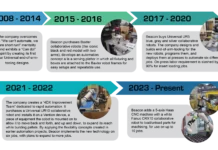by Stacy Shelly, regional commercial director
Midwest
AMCO Polymers
Plastics processors are driving efficiencies throughout their operations by ensuring equipment is up-to-date, optimizing facility costs and gaining a deep understanding of job scheduling. Resin pricing has received attention, too, with conversation centering around price stabilization and guarantees. However, the simple of act of qualifying more than one resin for each application could be one of the biggest cost savers in any processing operation. Some are choosing to gamble that one resin will be available without supply interruption for the life of a part. However, that gamble is increasingly risky.
Reasons for resin supply disruptions
A prime reason for resin availability uncertainty centers around aging North American resin-producing plants. Plant outages are happening more frequently today than even five years ago, due to aging facilities and infrastructure.
Costs to build a chemical or plastics facility in the US are astronomical, and a refinery hasn’t been built in the US since the 1970s. When additional capacity is needed, plant expansions are the norm – with many of the facilities originally constructed in the ’40s, ’50s or ’60s. Until recently, pricing margins didn’t allow companies to justify the cost of construction for a new plant. However, prices have continued to climb – particularly for polypropylene – and some new facility announcements have been made. In the meantime, North America had to become an importer as Asian plants – built to support the boom in China – are able to meet resin needs.
A second reason for resin disruption is that resin companies are searching for the same efficiencies in production that processors have implemented. Resin producers are consolidating and discontinuing product lines on a regular basis – particularly those that are more difficult to make. This leads to longer manufacturing production wheels/cycle times for all resins produced by that supplier.
For example, a resin plant might make 35 products, often transitioning from the production of one product to the next on a set cycle to maximize efficiencies. However, the number of products causes a higher number of transitions spread out over a longer period of time with smaller amounts of the products made. If some of those products can be removed, and the cycle time is shortened, the plant increases its efficiency and increases the amount of product it can produce.
Standard lead times for resin products today can go out as far as 24 weeks or more – unheard of 10 years ago – but it goes back to the production cycle. Companies may only have a product scheduled to be made every 20 weeks, and if a processor needs to order and catches the wrong point of the manufacturing cycle, it could cause production delays. Stocking distributors can help alleviate the longer production cycle after the initial startup of the program.
A third reason for resin supply disruption? Mother Nature. Weather events, from flooding to snowstorms, cause supply disruptions. Houston’s recent flooding is an example, since a major portion of polypropylene and polyethylene plants are in the Houston area. Pick any year: There’s always a product that is severely affected by weather, and if the truck drivers or rail cars cant make it from Point A to Point B, neither does the resin needed for a production job.
A fourth reason for resin supply chain problems: Transportation issues have increased significantly over the last 10 years. Every major freight company is deeply concerned about a shortage of drivers across all of North America. The rail industry also has been affected. The average lead time for a rail car of plastic has increased from two weeks to three weeks in recent years, in part due to the aging North American railroad infrastructure. Bridges are being shut down across the country because of safety concerns, which means rerouting railcars and lengthening – in some cases, significantly – the time and cost required for delivery.
Why specify and qualify more than one resin for an application?
Qualifying multiple resins from the outset for every application always is the best standard practice, but it is not often done due to time constraints or immediate costs concerns. Many molders recognize the importance of having multiple resin options approved in an application from the very beginning. To show their customers how important it is, some molders will charge their customers an additional fee for not having multiple resins approved up front, knowing the eventual costs that they (the molder) will incur when a supply chain interruption takes place.
Costs associated with approving replacement resins after an application has been qualified for commercial use are much higher than if multiple materials are approved during the initial consent process. Once a material has been specified for an application, the parts created in that material must be tested to ensure production standards and characteristics are met. If the initial material becomes unavailable and a new material must be tested, mold changeovers and samples – often charged by the hour – are performed. If the part is a high-performance or medical part, field testing could stretch for six to 12 months – or longer – before approval is given.
When possible, it’s recommended to qualify a domestic resin, an imported resin and a generic grade resin for every application for non-critical applications. For more critical applications, a domestic and imported resin, or multiple domestic resin approvals, are recommended.
Why qualify an imported material?
Most plants outside North America have newer technology and produce cleaner products at more competitive prices. This can be technology-related or resin feedstock-related, but either way, we live in a global market. Availability and pricing always are better somewhere in the world. Distributors can decrease the lead times associated with imported materials, and improving exchange rates and falling US tariffs also are making imported resins more attractive. North American molders have to compete globally.
An imported material could provide greater efficiencies or be a better fit for the application – or a domestic material could be the best choice. It makes sense to have options, whether those options are domestic or international.
Why qualify a distributor’s generic prime grades of resin?
Generally, availability is better for generic prime resins. Distributors keep generic prime resins in stock and position these resins to sell large volumes. These resins are guaranteed to meet two primary physical characteristics, but the supplier could vary. Pricing can be more attractive due to the higher volumes that are sold, and pricing mirrors the changing market conditions.
But, most importantly, generic prime products, by nature, open up the supply chain if one producer is having a manufacturing interruption. Most distributors will test and approve multiple producers’ resins that meet the generic prime specification. What does this mean to the molder? In normal supply situations, one primary producer’s resin is sourced to supply a specific generic product, keeping the processing setups very consistent. However, in times of material tightness due to supply disruptions, the fact that other producer materials have been approved to meet that generic grade’s specification allows material substitution without the molder or OEM experiencing the cost of qualifying another resin and the time it takes to work through that process.
Having the ability to switch between supply options will protect a molder from supply chain disruptions and keep the molder globally competitive. Any time more than one resin can be approved for an application, it is the best supply chain insurance policy a molder and OEM can have.
Conclusion
It happens more often than anyone wants to admit: An application only has one material approved, and the material producer decides to eliminate or consolidate that grade with minimal notice to the market. The OEM needs more than a year to approve another material in the application, so someone needs to purchase and stockpile that resin and incur the costs associated. Even simple requalification costs are higher after a product has become commercial, and in this case, they are even greater due to the timeline pressures. Everyone loses.
Cost reduction and production efficiency are the goals – for the molder, the OEM and the resin producer. That’s why resin grades are disappearing. To avoid supply chain disruption, it’s important to take steps at the very beginning of a new customer relationship to qualify more than one grade of resin. It protects everyone in the supply chain.
In a perfect world, every material application would have three resins approved: a North American-produced resin, an imported resin and a distributors’ generic prime resin. This allows the molder the maximum opportunity to keep the supply chain full and at the most competitive prices. At the very least, two resins should be approved, even if they are both from North America. This is a huge step in the right direction.
Stacy Shelly is regional commercial director-marketing director for Amco Polymers. He is a plastics expert with more than 25 years of experience in the areas of engineering resins, styrenics-based products and resin distribution. Amco Polymers is a family-owned business with a product portfolio that provides its customers with the highest quality products from industry-leading suppliers. Industry knowledge, integrity and dependability create unmatched value in the distribution marketplace. For more information, call 800.262.6685 or visit www.amcopolymers.com.





